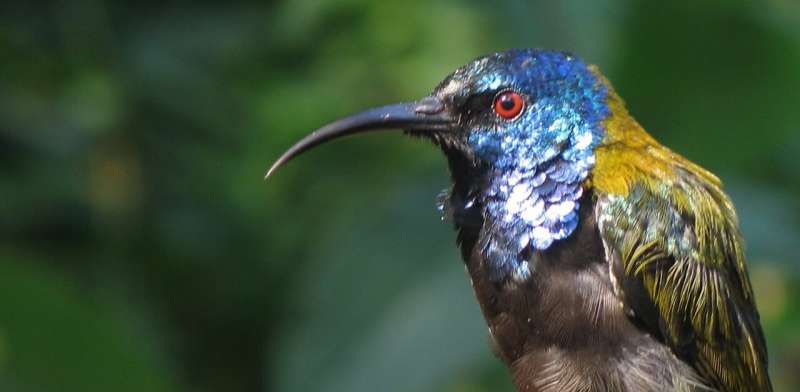
A Blue-headed Sunbird in the Albertine Rift: an example of a tropical bird with iridescent and colorful feathers. Credit: John Bates, Field Museum
The color palette of the birds you see out your window depends on where you live. If you’re far from the equator, most birds tend to have dull colors, but the closer you get to the tropics, the more likely you’ll see increasingly colorful feathers.
Scientists have long wondered why there are more brightly colored birds in the tropics than in other places, and they have also wondered how these brightly colored birds got there in the first place: that is, whether these colorful feathers evolved in the tropics, or whether tropical birds have colorful ancestors that came to the region from elsewhere.
In a study published in the journal Nature, ecology and evolutionScientists created a database of 9,409 birds to explore the distribution of colors across the world.
They found that the iridescent, colorful feathers came from 415 bird species across the tree of life, and in most cases from outside the tropics – and that the ancestor of all modern birds probably had iridescent feathers, too.
“For decades, scientists have hypothesized that there are brighter or more colorful bird species in the tropics,” said Chad Eliason, a researcher at the Field Museum in Chicago and lead author of the study.
“We wanted to find the mechanism that would help us understand these trends: how these bright colors appeared there and how they spread through the bird family tree over time.”

Birds of paradise in the Field Museum collections. Credit: Kate Golembiewski, Field Museum
Animals produce color in two main ways: pigments and structures. Cells produce pigments like melanin, which is responsible for black and brown coloration. Structural color comes from the way light bounces off different cell structures. Iridescence, the rainbow shimmer that changes depending on how light hits an object, is an example of structural color.
Tropical birds get their colors from a combination of bright pigments and structural colors. Eliason’s work focuses on structural color, so he wanted to explore this element of tropical bird coloration. He and his colleagues combed through photographs, videos, and even scientific illustrations of 9,409 bird species—the vast majority of the roughly 10,000 living bird species known to science. The researchers tracked which species had iridescent feathers and where these birds were found.
The scientists then combined their data on bird coloration and distribution with a pre-existing, DNA-based family tree showing how all known bird species are related to each other. They fed that information into a modeling system to extrapolate the origins and spread of iridescence. “We basically did a lot of math,” Eliason says.
Given the relationships between modern species and their locations, as well as general patterns of species formation and how their characteristics, such as color, have evolved over time, the modeling software determined the most likely explanation for the bird colors we see today: Colorful birds from outside the tropics often arrived in the region millions of years ago and then diversified into more and more different species. The model also revealed a surprise about the ancestor of all modern birds.
As a reminder, birds are a specialized group of dinosaurs: the oldest known bird, Archaeopteryx, lived 140 million years ago. A subgroup of birds called Neornithes evolved 80 million years ago, and this group became the only birds (and dinosaurs) to survive the mass extinction 66 million years ago.
All modern birds belong to the family Neornithes. The model developed by Eliason and his colleagues suggests that the common ancestor of all Neornithes, 80 million years ago, had iridescent feathers that still shimmer in the bird family tree.

Chad Eliason, lead author, with hummingbirds in the Field Museum collections. Credit: Kate Golembiewski, Field Museum
“I was very excited to learn that the ancestral state of all birds is iridescence,” Eliason says.
“We have already found fossil evidence of iridescent birds and other feathered dinosaurs, by looking at fossilized feathers and the pigment-producing structures preserved in those feathers. So we know that iridescent feathers were already around in the Cretaceous. These fossils support our model’s idea that the ancestor of all modern birds was also iridescent.”
The discovery that early Neornithes were likely iridescent could have important implications for paleontology. “We’re probably going to find a lot more iridescence in fossils now that we know how to look at it,” Eliason says.
While this new study sheds light on how iridescence spread through the bird family tree over millions of years, big questions remain. “We still don’t know why iridescence evolved in the first place,” Eliason says.
“Iridescent feathers may be used by birds to attract mates, but iridescence is also linked to other aspects of bird life.
“For example, tree swallows change color when humidity changes, so iridescence could be related to the environment, or some other physical property of the feathers, such as water resistance. But knowing more about how there came to be so many iridescent birds in the tropics could help us understand why iridescence evolved.”
More information:
Transitions between color mechanisms affect speciation dynamics and bird range distribution, Nature Ecology and Evolution (2024). DOI: 10.1038/s41559-024-02487-5
Quote:Scientists Figure Out Why There Are So Many Colorful Birds in the Tropics and How Those Colors Spread Over Time (2024, July 26) Retrieved July 27, 2024 from https://phys.org/news/2024-07-scientists-figure-birds-tropics.html
This document is subject to copyright. Apart from any fair dealing for the purpose of private study or research, no part may be reproduced without written permission. The content is provided for informational purposes only.